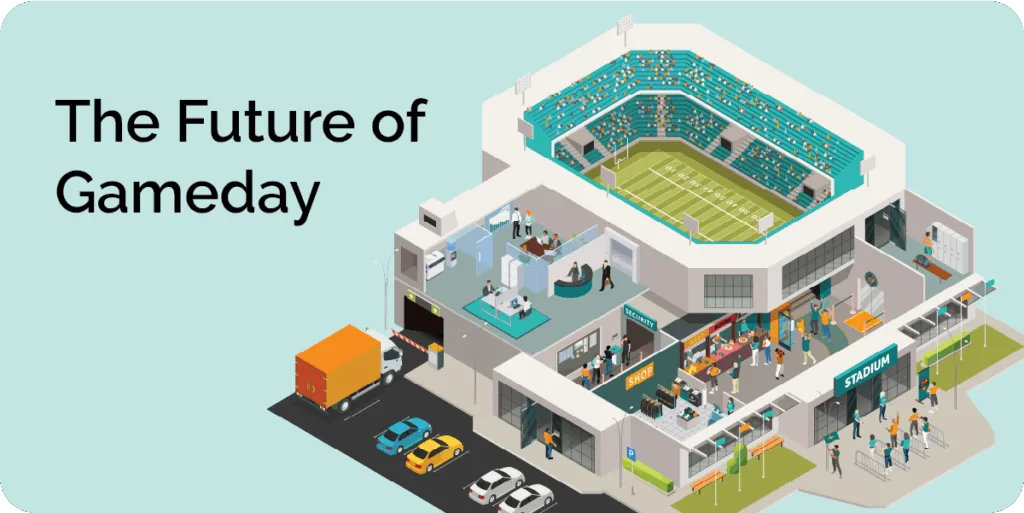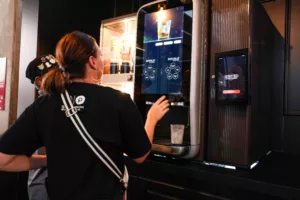Introduction
Over the last couple of years, Sports industry observers and fans alike have noted the increasing appetite for opt-in facial authentication technology in stadiums and other venues.
As the underlying biometric technology has matured—and the price point has sharpened—fans’ readiness to use it has also progressed. Today, with Wicket’s technology, fans can breeze into the stadium or buy a beer without pausing to pull out their phone, rating the super-fast face authentication “express lanes” a 9.7 out of 10 for satisfaction. Meanwhile, for the venue operator, facial authentication venue platforms like ours combine a great fan experience with improved operational efficiency and strengthened security—at a compelling price point. What’s not to like?
But there’s more to come. Wicket’s vision for the future of sports and live events has facial authentication as an enabler that will transform the gameday experience. In the coming sections, we’ll take you through this vision, and by the end of the article, you’ll understand why we’re so excited about the future!
Today
Wicket serves stadiums at every level: simplifying ticketing, concession payments, credentialing, and access control. These efficiencies don’t just enhance the fan experience; they also improve accountability, accuracy, and data reporting for staff and teams. And Wicket’s platform extends beyond these core scenarios. At its foundation, the technology offers a scalable set of common services —enroll and authenticate—that can adapt to virtually any use case and environment.
Such is the flexibility of Wicket’s technology that teams can choose where and how to deploy it, selecting between permanent and temporary touchpoints, “pause and go” or “just walk” con-ops, and whether to process individuals or groups. They can create unique workflows for Premium fans and deploy sensors to serve their staff, players, and visitors.
Furthermore, teams can brand this differentiated experience, bringing in dedicated sponsors who value the unique messaging opportunities. The “icing on the cake” is the positive Return on Investment that accompanies such deployments, where increased concessions sales and sponsorship revenue complement savings from operational efficiencies, creating a compelling business case for teams.
Tomorrow
Looking ahead, Wicket anticipates three major trends will impact this space.
1. Artificial Intelligence Makes “Everyone a VIP”
Sports enterprises, like every business today, are getting up to speed with the new value that AI can bring, both on and off the field. For fan experience advocates, this means the realization of a long-held dream: the ability to make everyone a VIP (beyond inventing a new way to “queue-jump”). Rather, the application of AI to the Fan Experience allows complete and compelling personalization of the Every-Fan Experience in ways that simply couldn’t happen before. Forget grouping fans into “cohorts” and messaging to them uniformly—fans can now be treated as true individuals. Every fan can get their own transformed, upgraded experience where personal touches abound. And with AI shouldering the load for the majority, venues can lavish increased human attention on the highest-value guests, where it will be especially valued.

2. The Fan Perspective: from Acceptance to Expectation
Today, teams often enquire, “How ready are fans to use facial authentication?” Tomorrow, they will find their fans demanding that their favorite venues implement the best technologies to ensure they can enjoy a superlative event experience. In the fight for fan dollars (and “butts in seats, as at-home viewing options get ever more compelling), teams need to make it a no-brainer that the best experience is in the building—watching the action live, in a frictionless stadium that really values their in-person support.
Looking outside the Sports industry gives us some supporting datapoints for this “from acceptance to expectation” progression. The introduction of biometric technologies to the travel security space, which enables travelers to clear security checks and border controls faster and with minimal interaction with officers, has been a major success. US Customs & Border Protection has effectively made facial biometrics the default option for both entry and exit, implementing the technology across processes for entering the United States at all international airports and for exit at 57 airports, as well as at many seaports and land border points of entry. In Canada, Europe, and beyond, where adoption is even more advanced, travelers actively seek out self-service kiosks and eGates to speed on their way. The travel security industry adopted Biometrics and turned it from a novel technology into the default mode in under 20 years.
We are watching the equivalent timeframe—“from acceptance to expectation”—shorten dramatically just a handful of years in the Sports world. Our first customer did something that had never been done before – and in the process, took four years to reach 15% fan adoption – but today, at leading deployments like the Tampa Bay Buccaneers and Salesforce’s Dreamforce, fans and attendees are opting in at astounding rates from day one. The shift is already underway—and for teams that want to stay ahead, the countdown has begun.
3. Value for Venues as they Truly “Know their Fans”
En route to cheering the winning goal, home run, or touchdown, fans have numerous interactions with the team, venue operator, and third-party suppliers, spanning trip planning and ticketing through post-event purchases and feedback.
The prospect of joining the dots of every fan journey—in order to optimize it for the individual fan, understand the broader fanbase, and tailor future experiences—is compelling. But today, this can only be done piecemeal, by forming speculative links between data elements such as credit card numbers, app logins, and loyalty accounts, and by adroitly navigating the plentiful gaps.
Tomorrow, teams using Wicket’s Facial Authentication will be able to “know their fans” more readily, as Wicket enables links across disparate fan interactions. With fans opting in to use facial authentication in ever-increasing numbers (a trend which is supported by the fact that sports teams are generally highly trusted by their fans), the quantity, quality, and value of the resulting data is going to skyrocket in the coming years.
Fan Experience of the Future: Beyond the Jumbotron
Teams and venues can expect venue-wide facial authentication to become the new normal for fans. What does this look like in practice?
- Fans will demand “Opt-In for Face” as their preferred option, for the personalized, streamlined experience that it offers
- “Venue ticket checks” will pivot to "Welcome events”, as security and ticketing checkpoints merge and become ever-more frictionless, and agents focus on greeting fans with personal acknowledgement
- Facial authentication will personalize the whole event—whether for wayfinding, payments, age checks, loyalty, or marketing—benefiting fans, teams, and venues alike
- Queues will be a thing of the past, as entry lanes and retail outlets operate at new levels of efficiency
- Teams will use new levels of fan data to imbue the gameday experience with “moments of delight” and to individually recognize and reward their fans beyond the Jumbotron.
And beyond: Teams will come up with new, creative ways to use facial authentication that work best for their fan bases. Part of the appeal of Wicket’s Facial Authentication platform is the ability for teams to deploy it widely without it becoming cost-prohibitive and to customize how, when, and where it’s used—the possibilities are limited only by imagination.
Where Next?
Wicket’s vision for the facial authentication-enabled venue experience paints an exciting picture: a great place to be for fans, and a profitable one for teams and venue operators.
With over 6M biometric transactions at 180 venues under our belt, and a compelling vision for the future, you can trust Wicket as the right partner to contribute to your organization’s Fan Experience future.







